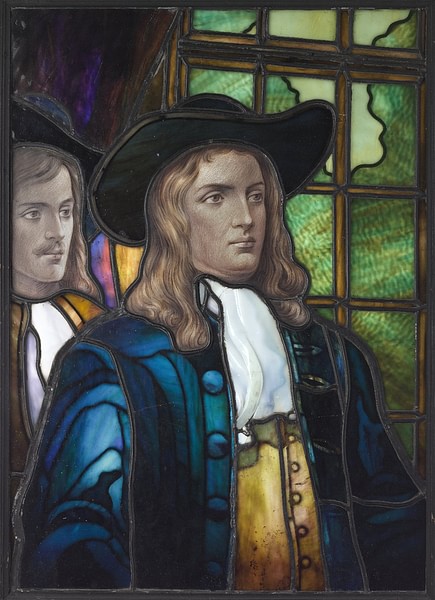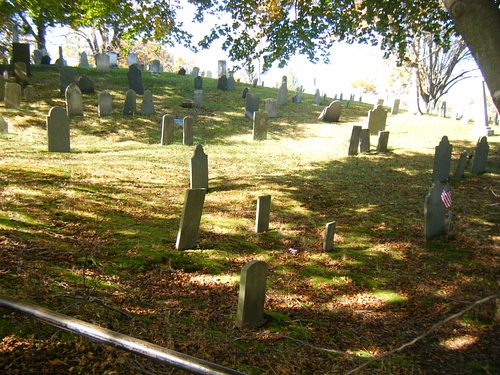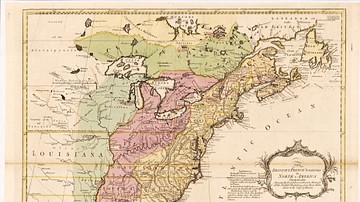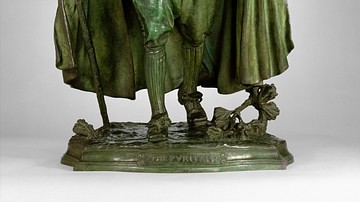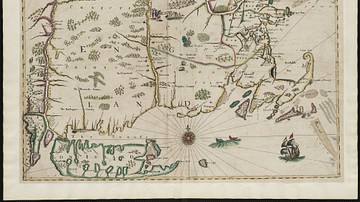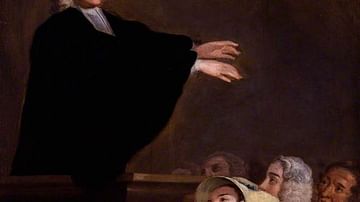Religion in Colonial America was dominated by Christianity although Judaism was practiced in small communities after 1654. Christian denominations included Anglicans, Baptists, Catholics, Congregationalists, German Pietists, Lutherans, Methodists, and Quakers among others. Religion was fully integrated into the lives of the colonists and completely informed their world view.
The New England Colonies had been founded by separatists – Anglicans who advocated separation from the Anglican Church – and Puritans – those who sought to purify Anglicanism of Catholic influences and practices – while the Middle and Southern Colonies were founded by Anglicans, Quakers, or in the case of Maryland, Catholics and non-conformist Protestants.
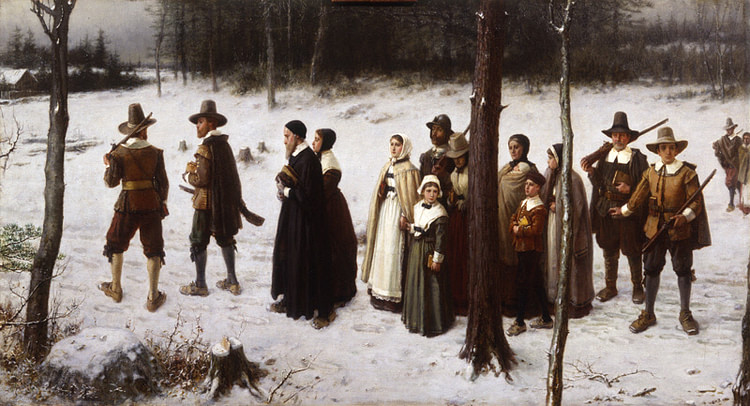
Jews and Catholics were the minority and were periodically persecuted for their faith, accused of witchcraft, and blamed for bad harvests and bad luck in general. By c. 1700, Native American religious practices had been condemned as satanic and were observed in secret or, at least, not widely advertised by participants. Atheism was not tolerated, and belief systems such as deism did not develop until the 18th century. Protestant Christianity understood as 'revealed religion' (based on scriptures) was the dominant religious force, which shaped colonial culture and, along with the Protestant rationalism of the 18th century, was integral to the foundation and diversification of the United States of America.
New England Colonies
The earliest colonies of New England were founded between 1620-1638 by separatists and Puritans seeking to establish religious communities in which they could worship freely. Both sects had been persecuted in England and, once they were firmly established in North America, then persecuted others. Their claim to have founded communities based on religious freedom extended only to their own beliefs with the exception of the Rhode Island settlements, which emphasized religious tolerance. The New England colonies made religion the priority and the peoples’ lives revolved around it. All work and leisure activities stopped on Saturday afternoon, when one’s thoughts were supposed to turn toward God exclusively, and would not resume until Sunday evening; Sunday, the day of rest, was spent in church.
Church services lasted all day with a short intermission for lunch which was provided at a nearby Sabba-day house (also known as a 'noon-house') – a kind of tavern or inn built near the meeting house specifically for this purpose. People were not allowed to return to their homes until Sunday services were concluded. Sermons were often between three and five hours long preceded by readings from the Bible and hymns sung without the accompaniment of an organ or any musical instrument. Since many people were illiterate, a deacon would sing a line of the hymn which the congregation would then repeat and so hymn-singing took up considerable time as did prayer.
Throughout the week, the citizens could and did wear brightly colored clothes, but on Sunday, they wore black or somber clothing, which was thought to signify repentance and sanctified thought. Church attendance was mandatory, and once the drum (or trumpet or conch shell or bell) was sounded for Sunday services, everyone was expected to get themselves to the meeting house and take their assigned seats (a deacon or sexton would go around and inspect homes to make sure everyone, except the sick, had gone to church). Seats were assigned according to social class with the leading citizens sitting up front and others behind them. Taking someone else’s seat was considered a serious offense, and the offender was fined, sometimes heavily. Men and women sat separately in some churches, together in others, and boys and girls were separated in most cases. Boys, considered more unruly, were seated toward the front of the church where they could be closely monitored. Boys who acted up during church were publicly beaten or otherwise disciplined afterwards.
Middle & Southern Colonies
The Middle Colonies had been under Dutch control until 1664 and followed the Dutch policy of religious tolerance and appreciation of diversity. Jewish communities were first established in New Amsterdam (later New York) in 1654 and the oldest Jewish dwelling still extant in North America, the Gomez Mill House in Newburgh, NY, dates to c. 1714. Although there were certainly religious conflicts between differing Christian communities in the region, they were not as marked as in New England where dissenters were exiled and hanged far more often.
In 1681, the wealthy Quaker William Penn (l. 1644-1718) established Pennsylvania which welcomed people of diverse faiths as well as Native Americans from different tribes. Unlike other colonies, Pennsylvania did not impose strict religious laws, but the Quaker interpretation of Christianity did inform its legal code, and people were expected to attend religious services weekly. Pennsylvania was the first colony to condemn slavery, mistreatment of Native Americans, and was also the first to pass a law mandating religious toleration and mutual respect between those of different faiths.
Quaker meeting houses, like those of other denominations, were also used for town meetings and posting of public notices.
The stocks and pillories (restraining devices for punishment) were usually located outside the meeting house in the town square. Meeting houses in New York, Delaware, New Jersey, and Pennsylvania were not painted as this was considered a show of vanity. They were made of wood or stone with oiled paper in the windows and, later, panes of glass nailed into the sills. The interior of the meeting house was dark with pews in the center and along the walls and, if the community could afford it, a gallery in the back, up a flight of stairs or reached by a ladder where the lowest classes – the African slaves and Native Americans – sat.
Dutch Reformed churches in New York had a bell suspended from a tree in front or above the door which was rung to bring people to services while other denominations fired a gun, had a person designated to blow a conch shell, or sounded a drum. Once the signal was given, as in New England churches, people were expected to attend no matter the season or the weather. Scholar Alice Morse Earle comments:
The churches were all unheated. Few had stoves until the middle of [the 19th] century. The chill of the damp buildings, never heated from autumn to spring, and closed and dark throughout the week, was hard for everyone to bear. In some of the early log-built meeting houses, fur bags made of wolfskins were nailed to the seats and in winter church attendants thrust their feet into them. Dogs, too, were permitted to enter the meeting house and lie on their master’s feet. Dog-whippers or dog-pelters were appointed to control and expel them when they became unruly or unbearable. (347)
Wolfskins were also nailed to the walls of a meeting house or church for insulation, and both men and women brought muffs to church to keep their hands warm. Women also brought foot-stoves – small, metal containers on wooden platforms filled with coals from the family fire – to warm their feet.
These considerations regarding warmth and comfort were observed in the Southern Colonies as well, though not to as great an extent. Jamestown Colony of Virginia, founded in 1607, held its first church meetings in the fort before it could afford to build a meeting house. Church attendance was mandated as strictly in Virginia as it was in New England.
The Virginia Cavaliers were a group of self-appointed “Sunday Keepers” who enforced the rules regarding peoples’ conduct on Sundays. No work was to be engaged in, no trade of any kind, no leisure activities, and one was supposed to remain in church – except for the allowed intermission for lunch – all day. When Sir Thomas Dale (l. c. 1560-1619) arrived in 1611 and established his strict laws of discipline and rule for the colony, he also declared that failure to attend church should be punishable by death – though this policy was never enacted. The Anglican Church dominated in Virginia, and dissenting sects were often persecuted. After 1750, when a large number of Baptists migrated to the region, they were frequently arrested, harassed, beaten, and invited to go elsewhere.
Maryland was initially founded as a haven for Roman Catholics who observed mass on Sundays but not for the duration of the day. Protestant colonists who migrated from New England and the Middle Colonies eventually ousted the Catholic magistrates, deported Jesuit and other Catholic priests, and remade the colony in their own image between 1644-1646 after which Anglican Protestantism dominated.
The Carolina colonies, and later Georgia, were more religiously diverse with a large Baptist community in Georgia. Even though Anglicans were not the majority, they frequently were the denomination in positions of power. As with the other colonies, religion informed one’s daily life, but rituals commonly associated with religious practice today – such as weddings and funerals – were not initially linked with a given church but could be civil affairs.
Marriages & Funerals
Marriages, like every other aspect of life, were conducted differently from region to region or colony to colony. Scholar David Freeman Hawke notes:
Marriage, in England a standardized ceremony controlled by the Anglican Church, took on a variety of forms in America. The steps leading to it remained fairly constant – negotiations between parents or guardians over the dowry, followed by a betrothal, or engagement as it would later be called – but the ceremony itself differed widely. The Dutch and Pennsylvania Germans performed it in their native languages. The Quakers held it in their meeting houses, where to the astonishment of strangers, a couple without benefit of clergy or any secular authority married themselves with vows often of their own devising. In the South, the Anglican rite embedded in the Book of Common Prayer remained intact, but local government interjected itself into what had once been the exclusive domain of the church. (92)
Marriages in New England could be officiated by any male in good standing with the community over the age of 21, while in the Middle Colonies a couple could be married by a civil or religious authority and, as in New England, marriage was not considered a significant event. It was thought to be only natural for people to marry and, in some cases, couples lived together without engaging in any kind of formal ceremony at all, though this was considered scandalous behavior.
Funerals were more standardized and were always presided over by a religious cleric of whatever denomination the deceased had belonged to. The corpse was prepared for burial in the home by the women of the family and then either buried in a plot on the family’s property, in the town cemetery or, eventually, in the graveyard of the church or meeting house. Early tombstones were simple stone slabs placed at the foot of a grave to prevent the deceased’s spirit – or corpse itself – from walking out. This was based on the Christian belief that God would raise the dead at the Last Judgment and one’s spirit could reanimate a corpse; some spirits, it was feared, might not want to wait and could arise earlier and want to return home. Eventually, the simple tombstone became a headstone and served the same purpose, but now they were ornately inscribed monuments honoring the deceased and placed at the head where the spirit would be able to see and appreciate it and rest easily.
Funerals followed this same progression of simple-to-complex. Initially, a funeral was a semi-private affair of the family and close friends but eventually turned into a social event where neighbors were invited to pay their last respects and then join in a communal meal. Hawke comments:
The once modest meal after the service became a feast. The well-to-do and even those who could not afford it passed out costly gifts to those who attended – scarves, gloves, even gold rings. As John C. Miller remarks, "Funerals tended to become an opportunity for the conspicuous display of wealth even more than grief." (93-94)
The funeral was one of the few rituals outside of Sunday service encouraged by the Puritans of New England who followed this same model of communal feasts, often quite lavish, following the burial. The once-simple funeral service, in which a minister might say a few words over the grave, also evolved into an elaborate affair where a family would pay a minister to give a full sermon and eulogy for the departed. This came to be considered a necessary aspect of burial to ensure the deceased would rest in peace and not return to haunt the living.
Superstitions & Slavery
Beliefs which are today regarded as superstitions were understood as simple facts of life by the colonists. Ghosts were an accepted part of the natural world, as were witches, demons, angels, and other spirits. Since the Bible was regarded as the inerrant word of God, and as the Bible made clear that such entities existed, there was no denying their existence without questioning the authority of the Bible. Signs and omens., it was thought, were regularly provided by God to help people better understand the seen and unseen world around them.
Thunder at a funeral, for example, was considered a good omen only if it sounded after the ritual was concluded; it was interpreted as a sign that the deceased’s spirit had arrived in heaven. If thunder sounded during a funeral, however, the spirit was thought to have been consigned to hell. In this case, judgment had been made according to God’s divine justice and mercy, and there was nothing to be done, but one could ward off bad luck on a regular basis in other circumstances by carrying amulets, talismans, reciting the Lord’s Prayer regularly, and taking other precautions to please God and avoid the attention of the devil.
Among these, it was thought, was the acceptance of chattel slavery as part of God’s plan. In addition to encouraging the belief in supernatural entities, the Bible also supported slavery through the narratives of the Old Testament and the epistles of the New Testament, especially the well-known line "Slaves, obey your earthly masters" from Ephesians 6:5 and the story of the slave Onesimus in the Book of Philemon who returns to his master willingly.
Those who objected to the practice of slavery were regarded in the same way as minority religious dissenters were: troublemakers who lacked a true understanding of God’s word and the Christian vision. Except for the Province of Pennsylvania, which condemned the practice, slavery was an accepted aspect of life in all the colonies and was tolerated, and at times embraced, even in Pennsylvania. African and Native Americans were regularly enslaved by the white colonists from c. 1640 in Virginia until the end of the American Civil War in 1865.
Teaching a slave to read – even to read the Bible – was against the law in many colonies, especially in the south, as it was thought to go against God’s plan. An educated slave was considered dangerous in that he or she might then stir up insurrection but was also thought to endanger their own souls by pursuing a course – such as education – denied them by God.
Conclusion
Whatever differences the colonists and their various congregations had with each other, they were in agreement with the line from Ecclesiastes 5:2 – "God is in heaven and you are on the earth; therefore let your words be few" – in that God was a reality, humans were subject to God’s will as revealed in the Bible, and the individual had no right to question the authority and inerrancy of the Bible. That authority, however, was defined by whichever Christian denomination was the majority and, unless one was hanged or otherwise executed for dissent, one could leave the colony and form one’s own based on a different interpretation of the Bible.
Massachusetts Bay Colony inspired the colonization of modern-day Rhode Island, Connecticut, and New Hampshire by exiling dissenters but, between 1659-1661, hanged Quakers (known as the Boston Martyrs) for spreading disruptive beliefs. People in the Middle Colonies who objected to the religious diversity often migrated to the Southern Colonies, especially Maryland and Virginia, where Anglicanism was firmly established by c. 1700.
Religious diversity in America and attendant conflicts continued throughout the 18th century but after the Great Awakening of the 1730s and 1740s – a spiritual revivalist movement encouraging a personal relationship with God – Protestant Rationalism prevailed among the upper classes which eventually began to influence those below them. The Founding Fathers embraced the concept of natural religion – God’s existence made apparent through the natural world – over that of revealed religion – God’s will revealed through scripture.
Rationalist philosophers began to exert a greater influence over colonial culture leading to the rejection of firmly held beliefs of the past, including the divine right of kings and other forms of God-ordained authority. Although revealed religion remained a constant in American culture, natural religion and Protestant Rationalism encouraged the movement that eventually led to the American War of Independence (1775-1783) and the establishment of the United States of America.
